Homeowners are uniquely positioned to leverage their home’s equity to secure financing. This is one of the reasons why HELOC Texas is gaining popularity in the state alongside home equity loans. By borrowing against the available equity in your property, you can tap into a low-interest source of funds compared to other loan types, as home equity financing typically has lower rates than personal loans or credit cards. Additionally, the interest paid on a home equity loan may be tax deductible, further enhancing its financial benefits.
At Defy Mortgage, we offer 75+ tailored mortgage solutions, including HELOCs, at competitive rates. We’ve provided both traditional and non-traditional financing products to a variety of clientele, from real estate investors and business owners to freelancers and 1099 contract workers. Whether you’re considering a HELOC for home improvements, debt consolidation, or funding long-term life goals, we have the tools and expertise to streamline the experience for you.
Using this extensive experience, we’ve crafted this blog to familiarize you with the requirements to get approved for HELOCs in Texas. We’ll go over the different eligibility criteria and documents you need to submit to get a HELOC. We’ll also discuss some state-specific restrictions on HELOCs that you should keep in mind to get the most out of this financing product.
Let’s get right into it!
HELOCs in Texas
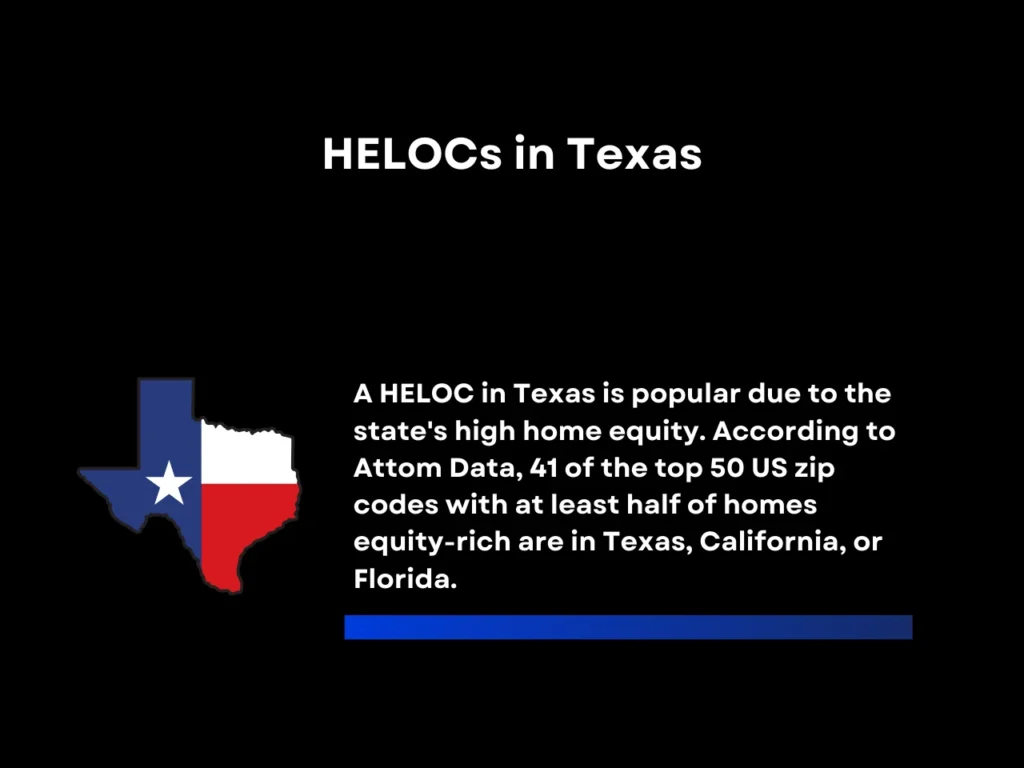
A HELOC Texas is a popular financial tool among homeowners due to the state’s high equity. According to Attom Data, 41 of the top 50 equity-rich US zip codes are in Texas, California, or Florida. With the state’s strong real estate market, Texans can get more out of their HELOCs.
Texas has one of the highest percentages of “true homeowners,” who have fully paid off their mortgages, giving them 100 percent equity. This allows them to tap into their home’s entire value (up to the cap imposed by their lender or state) to finance home improvements, consolidate debt, or fund major life events.
Defining a Home Equity Line of Credit (HELOC)
A Home Equity Line of Credit (HELOC) is a type of revolving credit line secured by the equity in your home, making it a second mortgage similar to a home equity loan. However, unlike a home equity loan that simply gives you a lump sum, a HELOC loan lets you draw funds as needed up to a certain limit and repay over time.
HELOC lenders give you a “draw period,” which is a limited time ranging from 5 to 10 years in which you can withdraw funds. After this period, you enter the repayment stage and cannot make new withdrawals until the full debt is repaid.
With a HELOC, you can withdraw money as needed and only pay interest for the amount withdrawn, offering more flexibility than a home equity loan, which requires paying interest at a fixed rate for the entire lump sum. This can be very inconvenient if you borrow more than you need at a given time.
A HELOC lets you tailor your debt obligation more dynamically, making it a more economical option for those with ongoing financial needs, like homeowners doing renovations or those with medical expenses.
Why HELOCs Are Popular in Texas
HELOCs in Texas are becoming more popular because of rising property values, especially in growing cities like Austin, Dallas, and Houston. These cities, known for their historically high home prices, are seeing a resurgence after a decline in 2023. Homeowners in these areas now possess a substantial amount of equity in their homes, potentially giving them a high borrowing limit should they decide to take out a HELOC.
With a high borrowing limit, borrowers can comfortably fund home renovations, education expenses, starting a business, and pursue other major goals. Since HELOC rates are variable, borrowers can strategically manage their line of credit to minimize interest payments compared to taking out a personal loan or using a credit card.
Unique HELOC Rules and Restrictions in Texas
There are certain laws that regulate Texas HELOCs to safeguard homeowners from over-borrowing. Keep the following restrictions in mind when taking out a HELOC in Texas:
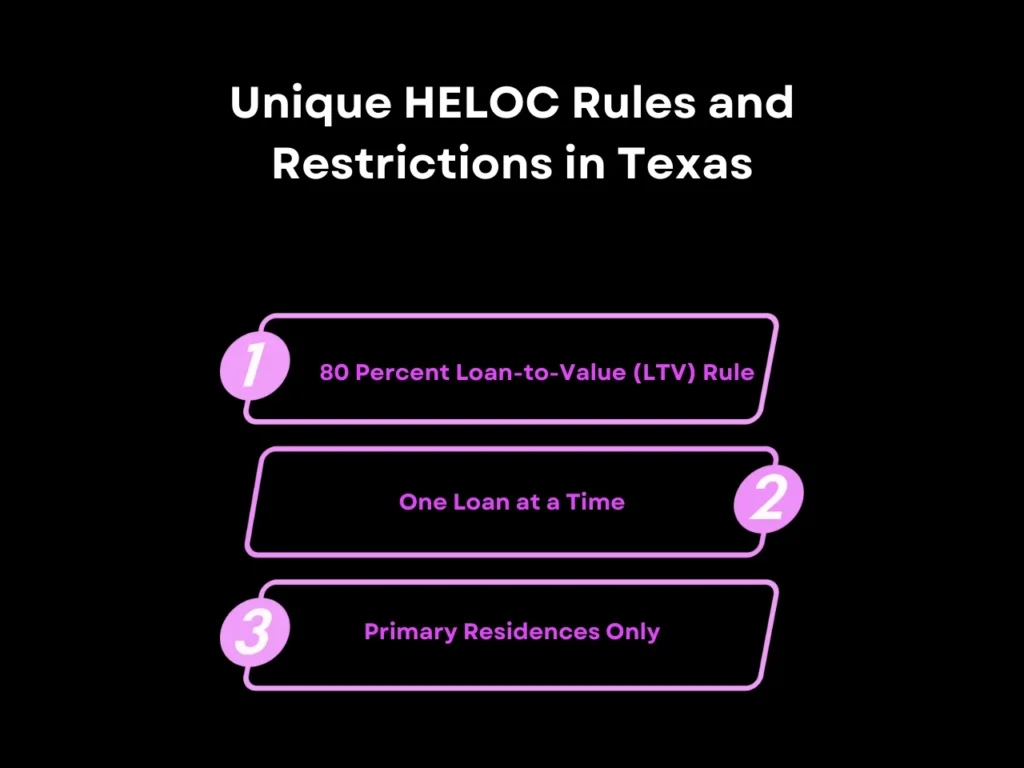
- 80 Percent Loan-to-Value (LTV) Rule: The combined total of your mortgage balance and HELOC must not exceed 80% of your home’s value. For example, if your home value is worth $500,000 and your mortgage balance is $240,000, your maximum HELOC credit limit would be $160,000. Keep in mind that not all lenders will provide up to 80% LTV – most lenders fall around the 85%-90% threshold.
- One Loan at a Time: Texas law (Article 16, Section 50(a)(6) of the Texas Constitution) prevents homeowners from taking out multiple home equity lines of credit. Only one loan against a home’s equity may be taken out at a time, either a HELOC or home equity loan, but not both.
- Primary Residences Only: While in some states it’s possible to take out a home equity loan or HELOC on an investment property – albeit it’s more difficult and expensive – you simply can’t do so in Texas. The state only allows homeowners to borrow against the property they’re living in.
These rules were designed to protect borrowers from excessive debt and potential home loss. If these restrictions are at odds with your needs, you might consider other financing options, such as a jumbo loan if you need more than what the 80 percent rule allows.
Eligibility Criteria for a Texas HELOC
Qualifying for a HELOC in Texas requires meeting several criteria. The most important are the minimum credit score, home equity, and income requirements. Let’s discuss them in more detail below.
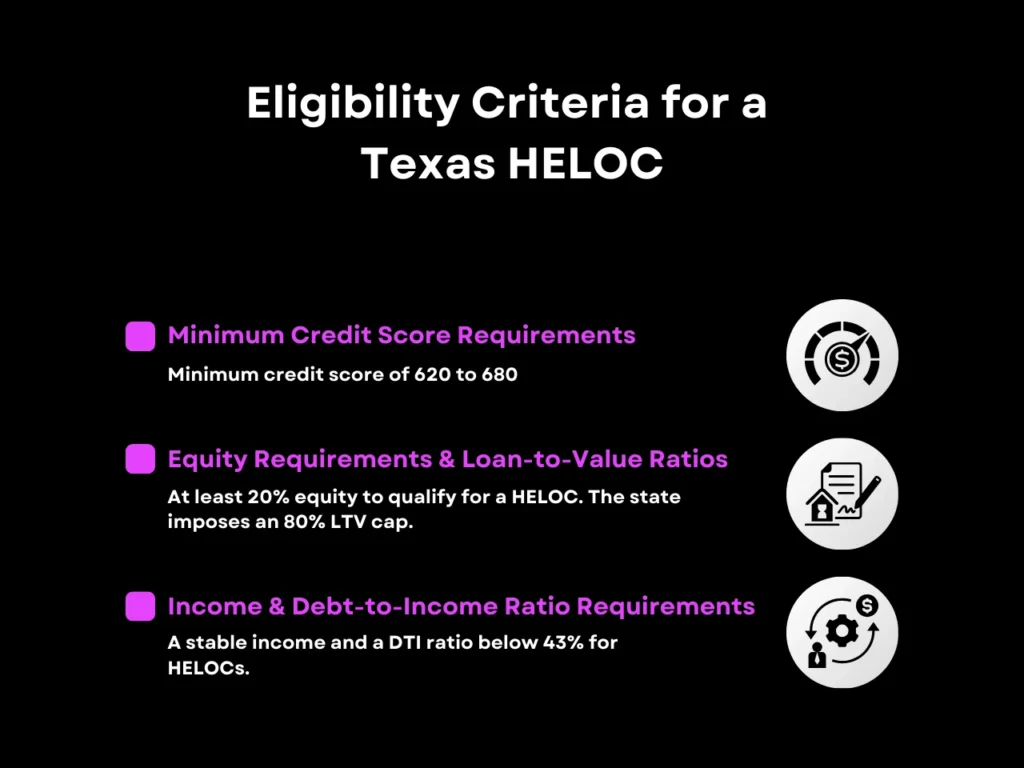
Minimum Credit Score Requirements
To qualify for a HELOC in Texas, you generally need a credit score ranging from 620 to 680. A higher credit score can help you secure better rates and loan terms. Lenders will examine your credit history, debt levels, and credit utilization before making an offer. At Defy Mortgage, our minimum FICO is 620 for HELOCs in Texas.
Equity Requirements and Loan-to-Value Ratios
Texas homeowners typically need at least 20% equity in their property to qualify for a HELOC. Additionally, the state imposes an 80% LTV cap, meaning that the total debt, including your primary mortgage and HELOC balance, cannot exceed 80% of your home’s appraised value. For example, if your home is worth $500,000, the combined debt from your mortgage and HELOC balance cannot be more than $400,000.
Income and Debt-to-Income Ratio (DTI) Requirements
Lenders look for stable income and a manageable debt-to-income (DTI) ratio to ensure you can fulfill your debt obligations. To prove that you have a reliable income, you will need to submit documentation such as W2 income or tax returns. If you are availing of a Stated Income HELOC, lenders may accept alternative documentation, such as bank statements and profit and loss statements.
Your DTI ratio, on the other hand, represents your monthly debt payments as a percentage of your gross monthly income. Lenders typically prefer a DTI of no higher than 43%-50% for HELOCs.
Key Documents Needed for a Texas HELOC
Applying for a HELOC in Texas requires gathering various documents to verify your financial situation, homeownership status, and other vital information that lenders need to assess your eligibility and decide on mortgage loan terms. Make sure you prepare the following documents:
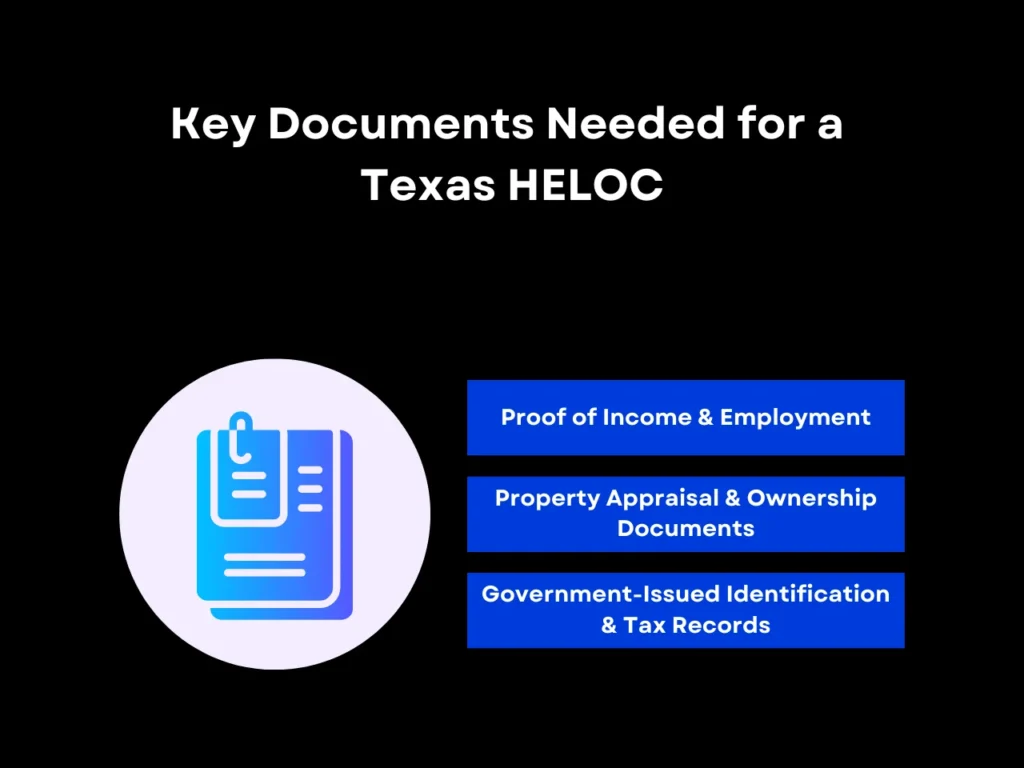
Proof of Income and Employment
Lenders ask for documents such as pay stubs, W-2 forms, and tax returns to verify your income. If you are self-employed, you can opt for a stated income HELOC, allowing you to provide alternative documentation such as profit and loss statements, 1099 forms, and bank statements to demonstrate consistent income.
Property Appraisal and Ownership Documents
You will need to provide a current property appraisal to verify the market value of your home and the available equity. You’ll also have to provide title documents and proof of ownership to show that there are no existing liens on your property.
Government-Issued Identification and Tax Records
Along with financial documents, lenders also ask for recent tax returns to verify your income and financial history more thoroughly. Much like other loans, you will also need to submit a government-issued ID, such as a driver’s license or passport, to confirm your identity.
HELOC Texas FAQs
What Is the Typical Approval Time for a HELOC in Texas?
Approval for a HELOC Texas usually takes between 2 to 4 weeks, depending on your chosen lender. Factors such as incomplete documentation and appraisal delays can prolong the approval timeline. Having a borderline credit score or needing further verification of your home’s value may also extend approval time.
Can I Get a HELOC in Texas With a Low Credit Score?
It is possible to be approved for a HELOC in Texas with a lower credit score, but this may result in higher interest rates or stricter terms, depending on the lender.
Are There Any Prepayment Penalties for Texas HELOCs?
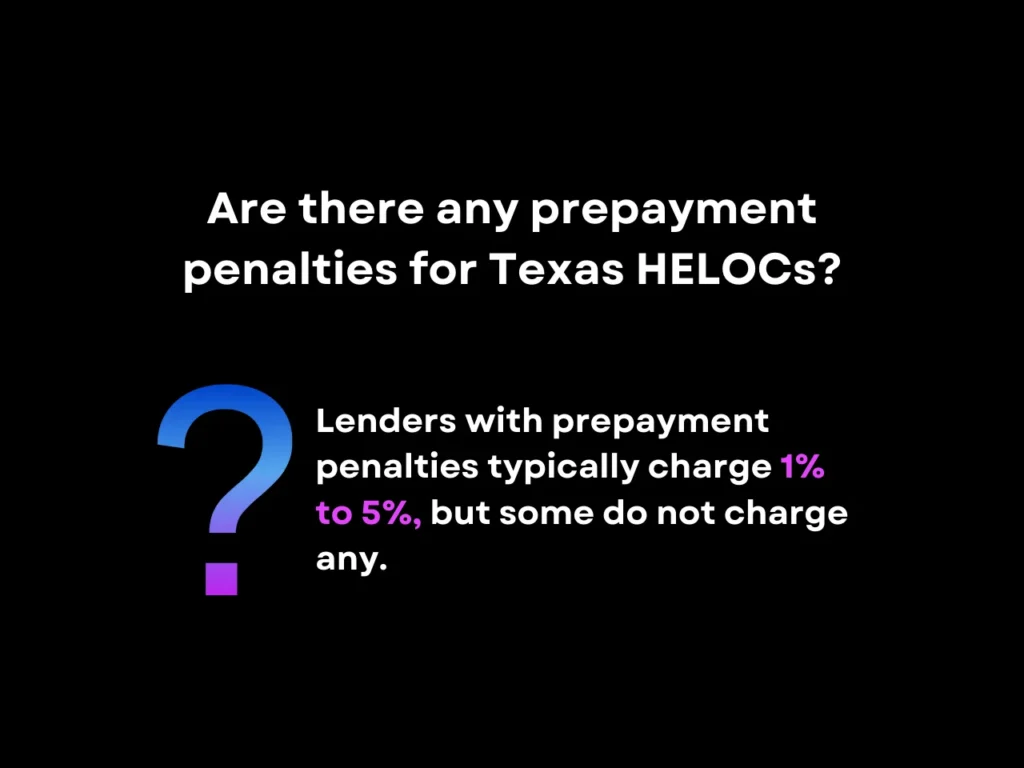
Prepayment penalties vary depending on the lender. Some lenders impose prepayment penalties, typically ranging from 1% to 5% of the loan, while others do not charge prepayment penalties at all.
How Does a Fluctuating Interest Rate Affect My HELOC?
Although the fact that HELOCs have a variable interest rate according to how much you borrow during the draw period can be an advantage, their variable nature also means that they fluctuate based on market conditions. HELOC interest rates vary based on the prime rate, which is influenced by the Federal Reserve’s policies. These policies are made in response to changes in the economic climate, so sudden market shifts could either increase or decrease your monthly payments.
What Happens to My HELOC if I Sell My House?

When you sell your home, you can no longer access additional funds from your HELOC. However, any outstanding balance on the HELOC, along with accrued interest, must be paid off. Typically, this payoff occurs when you close the sale, with the amount due deducted from the sale’s proceeds.
Key Takeaway
A HELOC Texas can be a more cost-effective way to access your property’s equity for various financial needs than a home equity loan. Although both have their strengths, HELOCs allow for flexible borrowing as needed, rather than taking a lump sum upfront as in the case of home equity loans, which is best for large purchases. This makes them an ideal option for homeowners who want access to funds over time for ongoing projects or expenses without having to pay interest on an amount they don’t yet need.
When applying for a Texas HELOC, remember to meet the minimum credit score, maintain a low debt-to-income ratio, and have sufficient home equity. Prepare key documents such as proof of income, property appraisal, and ownership documents in advance. Keep in mind that Texas imposes an 80% loan-to-value cap, restricts borrowing to primary residences, and only allows one home equity loan or HELOC at a time.
Are you looking for the best rates for HELOCs in Texas? Start a conversation with Defy or fill out a quick form to schedule an appointment. Let’s work out how we can tailor our loan options to your specific needs. No application fee or obligation EVER.




